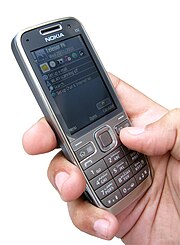
The Nokia N90 is a mobile phone, announced as part of Nokia's then-new line of multimedia devices, Nseries, on April 27, 2005. It had a unique swivel design encompassing four 'modes'. It has two displays and has a camera with Carl Zeiss optics and integrated flash, and can record video with audio. The screen can be swiveled 270° to mimic the appearance of a camcorder. The camera lens can also be swiveled. The 2.1-inch display has a pixel density of 259 ppi, considered the most crispest Nokia screen at the time, and continued to be joint-highest with the N80, E60 and E70 for four years, before being beaten by the Nokia N900 in 2009 with 267 ppi. The Nokia N90 can print with some printers over USB or over Bluetooth.
Series 40, often shortened as S40, is a software platform and application user interface (UI) software on Nokia's broad range of mid-tier feature phones, as well as on some of the Vertu line of luxury phones. It was one of the world's most widely used mobile phone platforms and found in hundreds of millions of devices. Nokia announced on 25 January 2012 that the company has sold over 1.5 billion Series 40 devices. It was not used for smartphones, with Nokia turning first to Symbian, then in 2012–2017 to Windows Phone, and most recently Android. However, in 2012 and 2013, several Series 40 phones from the Asha line, such as the 308, 309 and 311, were advertised as "smartphones" although they do not actually support smartphone features like multitasking or a fully fledged HTML browser.
The Nokia Communicator is a brand name for a series of business-optimized mobile phones marketed by Nokia Corporation, all of which appear as normal phones on the outside, and open in clamshell format to access a QWERTY keyboard and an LCD screen nearly the size of the device footprint.

The Nokia E50 Business Device is a bar-style monoblock quad-band mobile phone from Nokia announced 18 May 2006 as part of the Eseries, intended primarily for the corporate business market. It includes sophisticated e-mail support for Nokia's Intellisync Wireless Email, BlackBerry Connect, Visto Mobile, Activesync Mail for Exchange, Altexia as well as IMAP4. It also has the ability to view Microsoft Word, PowerPoint, and Excel attachments, and PDF documents but it cannot be used for editing these without additional apps. An application manager downloads, removes and installs both Nokia and third-party applications. Device to device synchronization is possible with Data transfer application. Features include EDGE, Bluetooth 2.0, a 1,280 × 960 pixels (1.3-megapixel) camera, a MicroSD memory-card slot, and digital music and video player functionality through RealPlayer and Flash Player. This unit does not support UMTS, Wi-Fi, or FM radio.
The Nokia E70 is a candybar/fold keyboard-type mobile phone from the Eseries range, announced in October 2005 and released in May 2006. There are two models of this phone, the E70-1 for the world market with tri-band GSM and UMTS, and the E70-2 for the Americas with tri-band GSM and EDGE packet data capability. Both models use the S60 platform 3rd Edition on top of Symbian OS version 9.1.
Mobile VoIP or simply mVoIP is an extension of mobility to a voice over IP network. Two types of communication are generally supported: cordless telephones using DECT or PCS protocols for short range or campus communications where all base stations are linked into the same LAN, and wider area communications using 3G or 4G protocols.
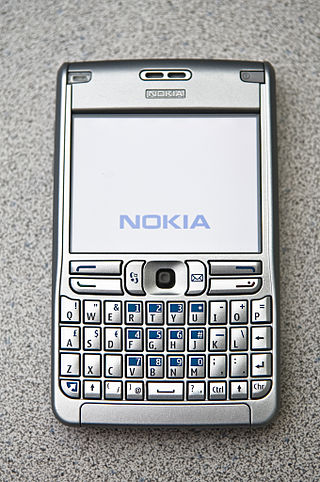
The Nokia E61 is a smartphone from the Eseries range, a S60 3rd Edition device targeting business users in the European market. It was announced as part of the new Eseries business line on 12 October 2005 along with the Nokia E60 and E70. As of Q4 2006, Cingular and Rogers Wireless deployed a similar yet restricted version designated the Nokia E62 in the North American and Brazilian markets. The E62 is substantially similar but without an 802.11 WiFi chipset or W-CDMA (UMTS) 3G support. E61 supports 900/1800/1900 bands, while E62 can operate in 850/900/1800/1900 in order to support American networks.
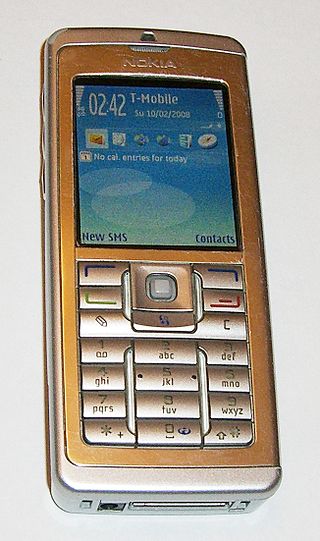
The Nokia E60 is a traditional candybar style mobile phone from the Eseries business phone range, an S60 3rd Edition Symbian device. It was introduced on 12 October 2005 along with Nokia E61 and Nokia E70.
Truphone is a GSMA-accredited global mobile network that operates its service internationally. The company is headquartered in London and has offices in ten other countries, being spread across four continents.

Nokia E51 is a Symbian OS mobile phone by Nokia announced on 18 September 2007 as the replacement of the Nokia E50 in the business-focused Eseries line. It was the second Nokia UMTS / HSDPA dual band device. The phone was available with a black, silver or bronze-coloured border and backplate. It has a slim body made of stainless steel, and was the smallest Nokia smartphone of the time, yet is still technologically capable like other S60 devices of the time. A version without the integrated camera also existed. The E51 was highly acclaimed and was succeeded by the Nokia E52.

The Nokia E71 is a smartphone introduced on 8 May 2008 from the Eseries range with a QWERTY keyboard targeting business users worldwide. It runs on Symbian OS v9.2, with a Series 60 3rd Edition, second generation Feature Pack 1. The Nokia E71 succeeded the Nokia E61/61i models, building on the base design and form factor but enhancing on the feature set.

This is a comparison of the various internal components and features of many smartphones.
The form factor of a mobile phone is its size, shape, and style, as well as the layout and position of its major components.
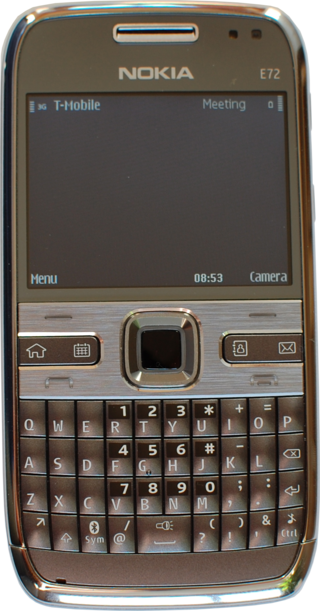
The Nokia E72 is a smartphone from the Nokia Eseries range manufactured in Finland. The Nokia E72 was announced on June 15, 2009 at the Nokia Connections 2009 event in Singapore. It is the successor to the Nokia E71 and is based on a similar design and form factor, and offers a similar feature set. The Nokia E72 is a business-oriented phone and has standard features including mobile email, calendar and instant messaging among many others with its Symbian-based S60 3rd Edition Feature Pack 2 operating system.

The Nokia X3 Touch and Type also known as Nokia X3-02 is a smartphone handset produced by Nokia. This is the first mobile handset released by Nokia that possesses a touchscreen in a "candybar" phone form factor. It is also the first touchscreen handset from Nokia that runs the Series 40 operating system. Previously released touchscreen devices from Nokia have either not had a physical keyboard, or they have had a slide-out, full-QWERTY keyboard. It was introduced on 13 August 2010 as one of the most advanced Series 40 devices in terms of features and specifications.

The Nokia Nseries was a high-end lineup of feature phones, smartphones, and tablets marketed by Nokia Corporation from 2005 to 2011. The Nseries devices commonly supported multiple high-speed wireless technologies at the time, such as 3G, or Wireless LAN. Digital multimedia services, such as music playback, photo/video capture or viewing, gaming or internet services were the central focus of the lineup. The lineup was replaced in 2011 by the Nokia Lumia line as the company's primary smartphone lineup.
Nokia's strategic nomenclature can be traced back in 2005 when the Nseries line was launched, offering devices with flagship specifications and premium hardware at various price points. These devices were considered the "bread and butter" of the company and were often positioned to showcase their latest technologies. Thanks to the newfound consumer and enterprise interest in smartphones at the time, the company introduced four additional collections to diversify their product portfolio and meet demands in most market segments. These new phone series were named Eseries, targeting small business and enterprise customers; Xseries, providing consumer-grade multimedia-focused devices; Cseries, which Nokia used to target both the low-end and mid-range market segments; and Tseries, for devices exclusive to the Chinese market.

Microsoft Lumia is a discontinued line of mobile devices that was originally designed and marketed by Nokia and later by Microsoft Mobile. Introduced in November 2011, the line was the result of a long-term partnership between Nokia and Microsoft—as such, Lumia smartphones run on Microsoft software, the Windows Phone operating system; and later the newer Windows 10 Mobile. The Lumia name is derived from the partitive plural form of the Finnish word lumi, meaning "snow".

The Nokia Asha platform was a mobile operating system (OS) and computing platform designed for low-end borderline smartphones, based on software from Smarterphone which was acquired by Nokia. The platform inherits UI similarities mostly from MeeGo "Harmattan", and replaced Series 40 on Nokia's low-end devices. The user interface design team was headed by Peter Skillman, who had worked previously on webOS and the design of MeeGo for the Nokia N9.
